Is Your Content Aligned
with Buyer Behaviour?
with Buyer Behaviour?
Matt Bell-Watson • 21 October 2021
As we explain in ‘The Priestley Guide to Creating Data-Driven Content That Engages New Customers’, the most effective content informs and educates. It offers useful, relevant information at an optimal moment in the sales funnel. But how do you know what information your buyers need and want at each stage of the sales journey?
Examining what prospects are searching for can give you powerful insights into what buyers need and want when they are researching and making purchase decisions. Discovering common terms and questions is a good way to understand how search intent and behaviour changes as buyers gather information and evaluate potential solutions.
It helps to think about the sales funnel in three stages – Discover, Learn and Decide. By identifying what terms your audience tends to use at each of these stages you can use this insight to inform your content and paid media strategies, ensuring that you are creating relevant content, appearing in the right places and driving engagement at the most important moments.
Consider how your content aligns with these three stages in the buyer journey:
1. Discover
At the top of the funnel, buyers are typically looking to find a solution to a problem they have or a way of achieving their goals. At this stage, we tend to see question-based terms like “how to automate customer onboarding” or “What is AML compliance?”.
This is a good point to produce thought leadership content, like whitepapers, blog posts or webinars, presenting solutions to common pain points or ways to seize new opportunities.
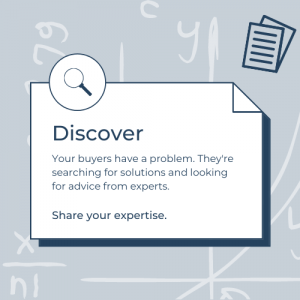
2. Learn
As buyers become more informed, searches tend to focus on specific solutions. Buyers are looking to understand who can help. We see searches like “best AML software” or “top KYC and AML service providers” that don’t name a vendor.
Look for opportunities to demonstrate your value proposition clearly. Ensure product pages, videos and other content highlights the most compelling benefits for your target audiences.
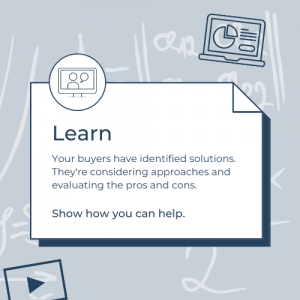
3. Decide
As buyers progress through the sales journey, search behaviour shifts again. Buyers may have a brand in mind or be evaluating a shortlist of vendors. Searches typically contain brand names like GBG, Yoti or Onfido, for example.
At this point, buyers are most interested in how-to guides and case studies. Think about how assets can be optimised to engage the audience, using interactive infographics, animation, video or ROI calculators.
Endorsement by third parties is powerful, so think about amplifying positive reviews or analyst reports through targeted content syndication, for example.
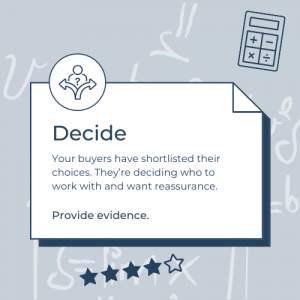
Aligning Content to Support Customer Growth
Understanding your customers’ behaviour and information needs can help you to plan what content to produce at each stage of the funnel. In turn, this can help your sales team to keep warm leads engaged and nurture relationships by arming them with highly relevant information that can be used to add value and communicate your USPs at the most pertinent moments.
By ensuring content is optimised for the keywords and questions customers are searching for, you can help your website to rise through the ranks in Google, so you can capture a greater share of search. Increasing your visibility in organic searches also has the benefit of decreasing the need to spend as much on paid search, conserving budget to grow your brand elsewhere.
Download Your Guide to Creating Data-Driven Content
In our special guide to creating data-driven content for B2B tech businesses, we provide practical examples, useful tips and advice on how to use social and search data to create engaging content that supports sales. Download your copy now.
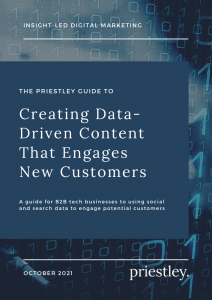
Is Your Content Aligned with Buyer Behaviour?
Matt Bell-Watson • 21 October 2021
As we explain in ‘The Priestley Guide to Creating Data-Driven Content That Engages New Customers’, the most effective content informs and educates. It offers useful, relevant information at an optimal moment in the sales funnel. But how do you know what information your buyers need and want at each stage of the sales journey?
Examining what prospects are searching for can give you powerful insights into what buyers need and want when they are researching and making purchase decisions. Discovering common terms and questions is a good way to understand how search intent and behaviour changes as buyers gather information and evaluate potential solutions.
It helps to think about the sales funnel in three stages – Discover, Learn and Decide. By identifying what terms your audience tends to use at each of these stages you can use this insight to inform your content and paid media strategies, ensuring that you are creating relevant content, appearing in the right places and driving engagement at the most important moments.
Consider how your content aligns with these three stages in the buyer journey:
1. Discover
At the top of the funnel, buyers are typically looking to find a solution to a problem they have or a way of achieving their goals. At this stage, we tend to see question-based terms like “how to automate customer onboarding” or “What is AML compliance?”.
This is a good point to produce thought leadership content, like whitepapers, blog posts or webinars, presenting solutions to common pain points or ways to seize new opportunities.

2. Learn
As buyers become more informed, searches tend to focus on specific solutions. Buyers are looking to understand who can help. We see searches like “best AML software” or “top KYC and AML service providers” that don’t name a vendor.
Look for opportunities to demonstrate your value proposition clearly. Ensure product pages, videos and other content highlights the most compelling benefits for your target audiences.

3. Decide
As buyers progress through the sales journey, search behaviour shifts again. Buyers may have a brand in mind or be evaluating a shortlist of vendors. Searches typically contain brand names like GBG, Yoti or Onfido, for example.
At this point, buyers are most interested in how-to guides and case studies. Think about how assets can be optimised to engage the audience, using interactive infographics, animation, video or ROI calculators.
Endorsement by third parties is powerful, so think about amplifying positive reviews or analyst reports through targeted content syndication, for example.

Aligning Content to Support Customer Growth
Understanding your customers’ behaviour and information needs can help you to plan what content to produce at each stage of the funnel. In turn, this can help your sales team to keep warm leads engaged and nurture relationships by arming them with highly relevant information that can be used to add value and communicate your USPs at the most pertinent moments.
By ensuring content is optimised for the keywords and questions customers are searching for, you can help your website to rise through the ranks in Google, so you can capture a greater share of search. Increasing your visibility in organic searches also has the benefit of decreasing the need to spend as much on paid search, conserving budget to grow your brand elsewhere.
Download Your Free Guide to Creating Data-Driven Content
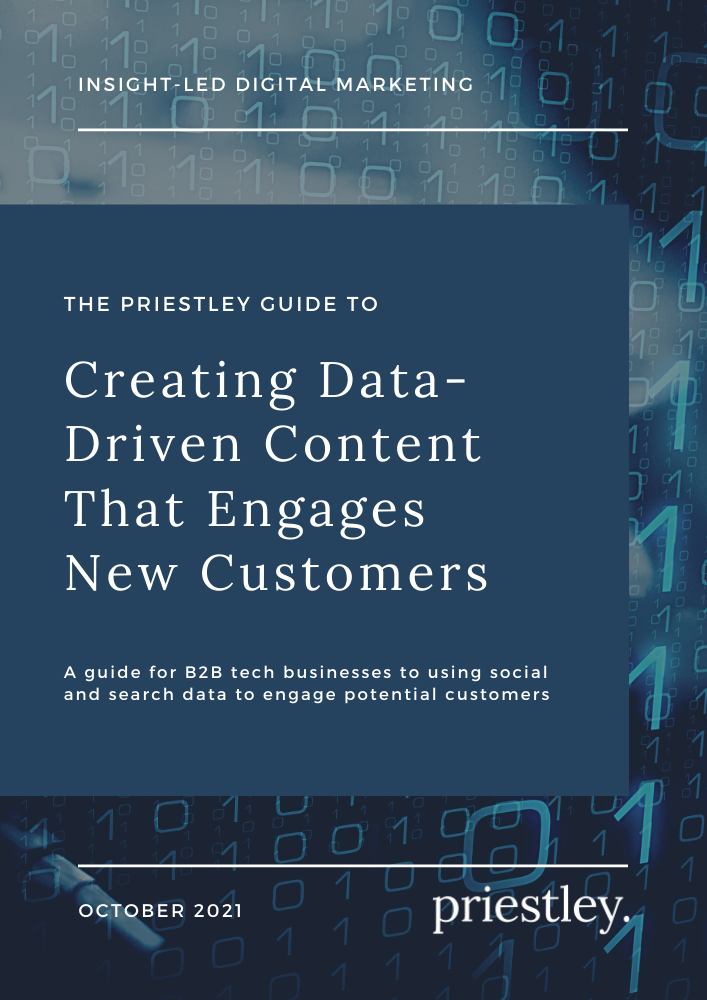 In our special guide to creating data-driven content for B2B tech businesses, we provide practical examples, useful tips and advice on how to use social and search data to create content that engages new customers and supports sales.
In our special guide to creating data-driven content for B2B tech businesses, we provide practical examples, useful tips and advice on how to use social and search data to create content that engages new customers and supports sales.
Download your free copy now.


Leave A Comment